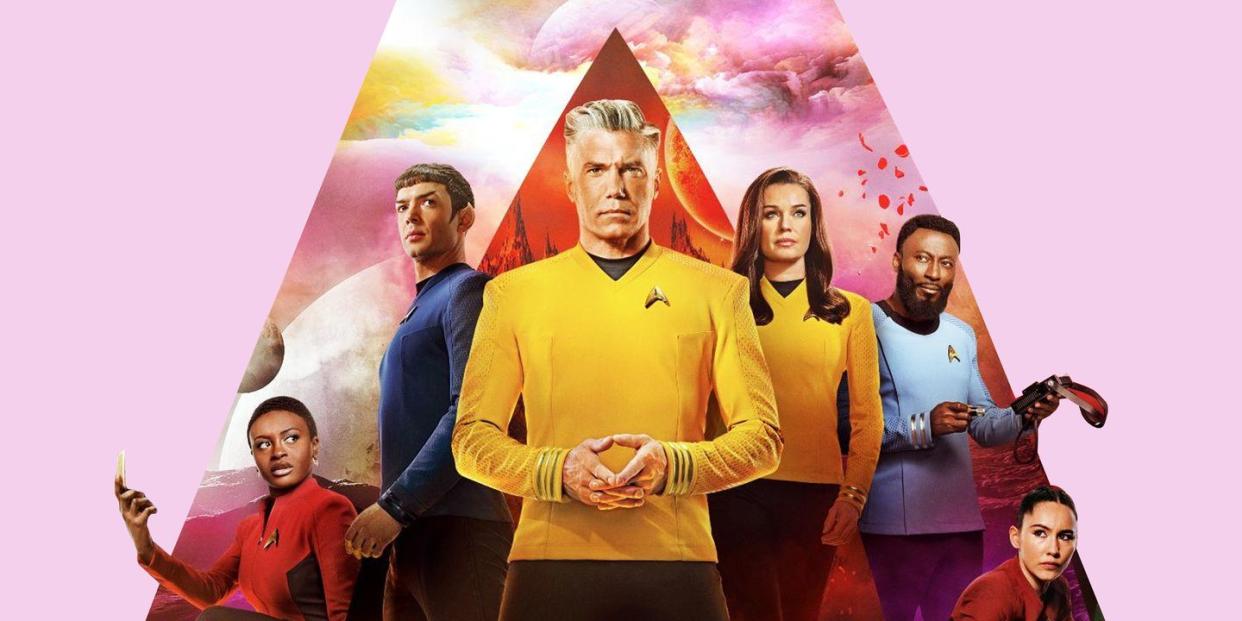'Strange New Worlds' Season 2 Is a Big Middle Finger to AI

- Oops!Something went wrong.Please try again later.
- Oops!Something went wrong.Please try again later.
As Season Two of Star Trek: Strange New Worlds beams up to Paramount+, the show’s writers should be toasting over Romulan Ale, singing a Klingon drinking song, and looking ahead to Season Three (which was greenlit back in March). But instead of walking the red carpet, they’re walking the picket line in Los Angeles, where they (along with thousands of other Writers Guild of America members) are striking for higher compensation, better residuals, and stricter staffing requirements, among other demands.
As I watched Season Two of Strange New Worlds against this backdrop, I couldn’t stop thinking about the series as an outstanding feat not just of filmmaking, but of writing. Like Season One before it, the newest season of Strange New Worlds, which premieres its first episode today, nimbly straddles a challenging tightrope. For non-Trek fans, it delivers exhilarating episodic science fiction, while for dyed-in-the-wool Trekkies, it functions as a prequel that informs and enlarges the canon of Star Trek: The Original Series. These ten episodes has different thematic concerns than the previous batch, but it’s every bit as focused on propelling the lore forward, to terrific success.
If you thought Season One tied a tidy bow on Captain Pike’s future, then you thought wrong. Season Two continues to plumb his canonical backstory for new insights; in one riveting episode, he returns to Rigel VII, the site of an ill-fated away mission imported straight from The Original Series. Meanwhile, a remixed version of “The City on the Edge of Forever,” centered on Paul Wesley’s James T. Kirk and Christina Chong’s La’an Noonien-Singh, somehow both subverts and pays homage to what’s arguably the best and most famous Star Trek episode of all time. Season Two also delivers on familiar Star Trek episodic conceits, like a classic courtroom drama that teases a famous Original Series court martial yet to come. All told, Strange New Worlds is a labor of love by writers who live and breathe Star Trek, sure, but also just get what it is: a way of using the future to tell gripping stories about who we are now.
Of course, it takes more than great writers to make great television. Strange New Worlds is firing on all nacelles this season—it’s turbocharging what worked about Season One, while also giving viewers more of what they want. As with Season One, the series remains committed to rifling through genres; this time out of space dock, it delivers horror, comedy, romance, and so much more. In one standout episode, the spiritual sequel to Season One’s Vulcan body swap caper, another cosmic mishap finds Spock in uncomfortably close contact with his human side—a comedy of manners and deception played to great comedic effect by Ethan Peck and Anson Mount. Meanwhile, cast members like Celia Rose Gooding and Melissa Navia finally get to anchor their own episodes, as Season Two sheds its predecessor’s focus on Captain Pike to become a true ensemble series. Ensemble shows can’t have weak links, and the Strange New Worlds ensemble (newly joined by Carol Kane as a kooky chief engineer with fascinating secrets) is a deep bench of gifted actors.
But about that writer’s strike: also among the guild’s concerns is the matter of artificial intelligence. Concerned that studios will use AI to generate source material, punch up existing scripts, or outright draft screenplays, the Writers Guild is seeking regulations around how and when AI can be used. When it comes to Star Trek, the irony here is rather rich—after all, Star Trek characters have been bedeviled by rogue AI since the franchise debuted in 1967, from malevolent supercomputers to hostile cybernetics to android doppelgangers. Star Trek has no unified theory of artificial intelligence (in fact, The Next Generation’s enduring questions about an android commander’s sentience and soulfulness make for some of the franchise’s best viewing), but it’s certainly never shied away from telling cautionary tales about automation.
Could AI consume six decades of Star Trek lore and come back with anything remotely resembling this stellar season of Strange New Worlds? In the absence of The Original Series AI baddies like Landru and Vaal, I asked ChatGPT to do the honors. The app generated a Strange New Worlds teleplay called “The Vortex of Time,” in which a temporal anomaly threatens to shatter the space-time continuum (where have I heard that one before?). Captain Pike orders his crew around like a wooden actor in a management training video until Spock, Number One, and “Lieutenant Connolly” trace the problem to a research station, stabilize its malfunctioning temporal core, and save the galaxy (all in a day’s work for Starfleet’s finest). ChatGPT gamely mimics Starfleet’s militarized patter, but ultimately, all it can generate is a serviceable Star Trek conceit. The layer of depth that makes Star Trek sing—its thoughtful attention to what these outer space dust-ups signify about our culture, our morality, and our humanity—is utterly absent here. Sure, ChatGPT can string together a rudimentary plot, but it can’t tell stories with soul.
If there’s one thing any Star Trek fan knows, it’s that even the smartest computers in the galaxy are ultimately just window dressing. They perform complex calculations, beam officers from place to place, and make bridge consoles go “beep boop.” At the end of the day, it’s the people that make the starships soar. Hollywood studios would do well to recognize it.
You Might Also Like

